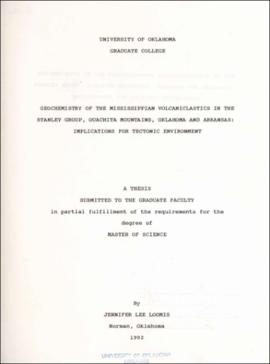| dc.contributor.author | Loomis, Jennifer Lee | |
| dc.coverage.spatial | Oklahoma | |
| dc.coverage.spatial | Ouachita Mountains | |
| dc.coverage.spatial | Arkansas | |
| dc.coverage.spatial | Ouachita Mountains | |
| dc.date.accessioned | 2023-04-21T17:00:17Z | |
| dc.date.available | 2023-04-21T17:00:17Z | |
| dc.date.created | 1992 | |
| dc.date.issued | 1992 | |
| dc.identifier.uri | https://hdl.handle.net/11244/337453 | |
| dc.description | Thesis (M.S.)--University of Oklahoma, 1992. | |
| dc.description | Includes bibliographical references (leaves 152-158) | |
| dc.description.abstract | A total of 46 tuff samples from the Mississippian Stanley Group in outcrop and 8 rhyolite samples collected cores near the Sabine Uplift in Sabine County, Texas, have been analyzed for major element, trace element and rare earth element abundances. The effects of differential settling of crystals during deposition, diagenesis and weathering on tuff geochemistry have been characterized.
Despite post-eruptive alteration and modification of the Stanley tuffs, enough of the igneous geochemical signature remains so that tuff geochemistry can be used to determine what type of tectonic setting was present along the Paleozoic southern North American plate margin. A study of young rhyolites and tuffs from known, present-day tectonic settings provides the framework by which to determine which geochemical characteristics can be used as tectonic discriminants. The presence of a Ta-Nb trough (and whether or not it is persistent throughout the samples of a volcanic suite), the variability and extent of Ba and Sr depletion, and the extent of mobile-element
enrichment relative to mid-ocean ridge basalts are the geochemical features which can be collectively used to determine the tectonic setting of high-silica volcanics.
Use of these geochemical features suggests that the Stanley tuffs and the Sabine rhyolite are associated with a continental island-arc system. In addition, plotting the tuffs and rhyolite samples on the granite tectonic
discrimination diagrams developed by Pearce et al. (1984) implies that_ the Ouachita volcanics may have a back-arc basin component. | |
| dc.format.extent | xii, 164 leaves | |
| dc.format.medium | xii, 164 leaves : ill., maps (some col.) ; 29 cm. | |
| dc.language.iso | eng | |
| dc.subject.lcsh | Volcanic ash, tuff, etc.--Oklahoma--Ouachita Mountains | |
| dc.subject.lcsh | Volcanic ash, tuff, etc.--Arkansas--Ouachita Mountains | |
| dc.subject.lcsh | Plate tectonics | |
| dc.subject.lcsh | Geology, Stratigraphic--Mississippian | |
| dc.title | Geochemistry of the Mississippian volcaniclastics in the Stanley Group, Ouachita Mountains, Oklahoma and Arkansas: implications for tectonic environment | |
| dc.type | Text | |
| dc.contributor.committeeMember | Robert Fay | |
| dc.contributor.committeeMember | Richard Nicholas | |
| dc.contributor.committeeMember | Barry Weaver | |
| dc.contributor.committeeMember | Harvey Blatt | |
| ou.group | School of Geology and Geophysics | |
